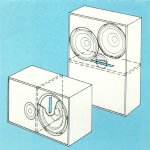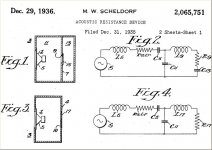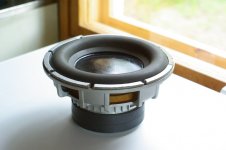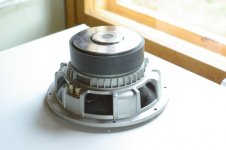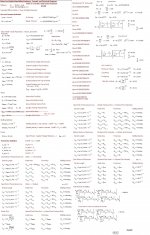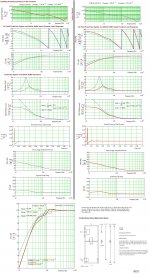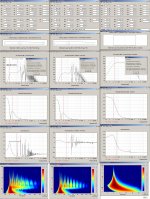Hello
I have an inexpensive 10" woofer which I am planning to use as a subwoofer for some increased low frequency extension. I measured and calculated the Thiele/Small parameters for the 10" woofer and it seems like it could perform fairly well in a 32 liter/1.13 cu.ft. sealed enclosure.
I enclosed a WinISD .wdr file for this woofer, but here are the main parameters.
Qms = 3.4
Qes = 0.538
Qts = 0.465
Fs = 30.4 Hz
Vas = 48.3 L
Fs / Qes = EBP
30.4 / 0.538 = 56.5
The other two pictures show a loudspeaker enclosure principle which utilizes two sealed chambers which are connected to each other via a "resistive" port. Does this kind of alignment have certain advantages when compared to a regular sealed enclosure?
I would be interested if somebody has more information or experience regarding this type of speaker enclosure.
Best regards
I have an inexpensive 10" woofer which I am planning to use as a subwoofer for some increased low frequency extension. I measured and calculated the Thiele/Small parameters for the 10" woofer and it seems like it could perform fairly well in a 32 liter/1.13 cu.ft. sealed enclosure.
I enclosed a WinISD .wdr file for this woofer, but here are the main parameters.
Qms = 3.4
Qes = 0.538
Qts = 0.465
Fs = 30.4 Hz
Vas = 48.3 L
Fs / Qes = EBP
30.4 / 0.538 = 56.5
The other two pictures show a loudspeaker enclosure principle which utilizes two sealed chambers which are connected to each other via a "resistive" port. Does this kind of alignment have certain advantages when compared to a regular sealed enclosure?
I would be interested if somebody has more information or experience regarding this type of speaker enclosure.
Best regards
Attachments
Since it doesnt utilize the backwave, like TH or BR do, and doesnt add resonance to the frontwave, like FLH or BP do, it will behave exactly like a sealed enclosure of similar size. if you want to know exactly, get AKABAK and simulate it.
If you want to get the most out of your driver and dont mind investing some time, get hornresp and see what you can do beyond sealed enclosures.
If you want to get the most out of your driver and dont mind investing some time, get hornresp and see what you can do beyond sealed enclosures.
Thanks for your reply and suggestion.
I'm not at all familiar with horn loudspeaker design, but it's my understanding that large volume may be needed for a well-functioning horn bass enclosure. But unfortunately I cannot allow for much larger than 40 liters of volume for this bass speaker as I would prefer it to be quite compact.
I attached two pictures of this 10" woofer. Its maximum excursion is approximately 8 mm (one-way), I measured it with a micrometer.
I'm not at all familiar with horn loudspeaker design, but it's my understanding that large volume may be needed for a well-functioning horn bass enclosure. But unfortunately I cannot allow for much larger than 40 liters of volume for this bass speaker as I would prefer it to be quite compact.
I attached two pictures of this 10" woofer. Its maximum excursion is approximately 8 mm (one-way), I measured it with a micrometer.
Attachments
Hi,
There is more to this type of box:
http://www.diyaudio.com/forums/subw...e-braking-one-coil-shorted-3.html#post1120925
http://www.diyaudio.com/forums/multi-way/83982-enclosure-high-q-driver-3.html#post976183
b
PS: IMO: If the box would have a smaller volume,this approach should give a good result but then it may no more qualify for a 'Sub'.
There is more to this type of box:
http://www.diyaudio.com/forums/subw...e-braking-one-coil-shorted-3.html#post1120925
http://www.diyaudio.com/forums/multi-way/83982-enclosure-high-q-driver-3.html#post976183
b
PS: IMO: If the box would have a smaller volume,this approach should give a good result but then it may no more qualify for a 'Sub'.
Attachments
a bassreflex could maybe fit in these 40 liters. it adds alot of low frequency output compared to a closed box, but makes a highpass or rumble filter necessary to avoid overexcursion. bandpass is also an option compared to closed box, used for limiting the high frequency output, which can lower distortion and localisability (is that a word?). if you combine both, you get a 6th order bandpass, which adds the most output. hornresp can sim those too.
btw, cool stuff, bjorno
btw, cool stuff, bjorno
a bassreflex could maybe fit in these 40 liters. it adds alot of low frequency output compared to a closed box, but makes a highpass or rumble filter necessary to avoid overexcursion. bandpass is also an option compared to closed box, used for limiting the high frequency output, which can lower distortion and localisability (is that a word?). if you combine both, you get a 6th order bandpass, which adds the most output. hornresp can sim those too.
btw, cool stuff, bjorno
Hi, I too was thinking about suggestion a BP-box to lower the 'localizability ' but I would first pick a simple 4:th order considering the Driver T/S and the OP requirement of a small box.. but usually I prefer(post) examples of the more build challenging T-TQWT types always somewhat larger in volume but not necessarily in the required floor footprint.
b
Attachments
What you have posted are pictures of the Dynaco A50 & A35 -- these are generally classed as aperiodic. The patent is new to me, thanx. That it is of the vinatge that it is is interesting.
Naim does some enclosures like this, explaining that at high frequencies the small box is "seen" by the driver, at lower frequencies the 2nd chamber comes into play.
http://www.t-linespeakers.org/classics/dynaco.html
dave
Naim does some enclosures like this, explaining that at high frequencies the small box is "seen" by the driver, at lower frequencies the 2nd chamber comes into play.
http://www.t-linespeakers.org/classics/dynaco.html
dave
Hi,
There is more to this type of box:
http://www.diyaudio.com/forums/subw...e-braking-one-coil-shorted-3.html#post1120925
http://www.diyaudio.com/forums/multi-way/83982-enclosure-high-q-driver-3.html#post976183
b
PS: IMO: If the box would have a smaller volume,this approach should give a good result but then it may no more qualify for a 'Sub'.
Hello
Thank you for your simulated data!
If I understand the graphs on your third attachment correctly, it wouldn't be of much use to place this woofer into a two-chamber enclosure of this size.
Nevertheless, it's interesting to notice that the figure 6-4 in your first attachment does show some increased low frequency extension. As the text says:
...The parallel mass and resistance not only reduces the peak by about the same magnitude, it significantly lowers the cutoff frequency. In this respect, it is a definitive improvement on the single-cavity system with acoustic damping of the driver...
I'm not very fluent with the technical terminology. Does "parallel mass and resistance" in this paper mean that the two cavities are connected with some kind of "lossy resonant device" (such as a slightly resistive bass reflex tube)? Or did I get totally off track?
Now it looks like I should go with a regular sealed enclosure with this woofer. But as MaVo suggested, I will consider adding a bass reflex tube into it.
Once again; thanks for replies
..If I understand the graphs on your third attachment correctly, it wouldn't be of much use to place this woofer into a two-chamber enclosure of this size.
Right,...It depends on the observation of your driver data where Qts= 0.465 that in a 32 L box would return a Qtc of ~0.73 and if ported the optimal volume is about 80L + your earlier request that it should be a 2-chamber closed design:
I calculated a Qtc for a 16L chamber (Closed box/2) would be ~0.93.
The enclosure volume you favor is in conflict with the picture you posted : Planet10 remarks are good, the shown drawing depicts aperiodic Dynaco A50 & A35 designs and are totally different in operation compared to what you proposed as the enclosure volumes are terminated with an aperiodic port(s). My simulations didn't take this fact into consideration at all as this was not requested.
At any case your pick of volume would not work well in a Dynaco style unless you increase the internal enclosure volume.
Nevertheless, it's interesting to notice that the figure 6-4 in your first attachment does show some increased low frequency extension. As the text says:
...The parallel mass and resistance not only reduces the peak by about the same magnitude, it significantly lowers the cutoff frequency. In this respect, it is a definitive improvement on the single-cavity system with acoustic damping of the driver...
Here,I guess you missed the last part of your quoted sentence: ' with acoustic damping of the driver' as this refers only to the * marked part of 'Small' :
Two-chamber sealed enclosure..JPG picture that is only supported by Small himself via a private mail conversation ,never officially published before but here.
I'm not very fluent with the technical terminology. Does "parallel mass and resistance" in this paper mean that the two cavities are connected with some kind of "lossy resonant device" (such as a slightly resistive bass reflex tube)? Or did I get totally off track?
No, The parallel mass and resistance Small mentioned is a superior method compared to any of the two camber methods, closed or ported: aperiodic or not, and is congruent with what Ive earlier have posted here:
http://www.diyaudio.com/forums/subw...e-braking-one-coil-shorted-3.html#post1120919
Picture:
http://www.diyaudio.com/forums/subw...e-braking-one-coil-shorted-3.html#post1120925
The in the submitted encircled components are the "parallel mass and resistance", not earlier shown in the posting to your thread.
So this is a separate method(Small referred to) that can be applied to most speaker drivers in order to change the Qts of a driver to better fit a too small enclosure.
The only penalty to pay is a lover driver efficiency/ sensitivity.
In my simulation,in your thread, I placed with density # 1 two layers of damping material near the rear of the driver in order to load the cone similar to the "parallel mass and resistance" method.
This way was only IMO useful to a small degree as the 'MJK' 'yellow' plot color shows.
You can lower the Qtc=~0.732 down a bit,but paying with a resulting small rippled response.
Now it looks like I should go with a regular sealed enclosure with this woofer. But as MaVo suggested, I will consider adding a bass reflex tube into it.
Yes and Yes I would too choose MaVo's suggestion, i.e. If using an enclosure volume >= 40 L.
Then all the mentioned methods could be applied with a great success including a low cut-off FR : Planet 19's Mavo's and any of Smalls would work fine.
Otherwise, you have to fight with severe diminishing returns = a suboptimal sub(mid-bass) if when using your suggested too small enclosure volume.
b
Hi there, d1030180, I'm interested in knowing if you pursued the dual-chamber design or if you found more information on it outside this forum. I'm also looking at designing a speaker with a 10" bass unit. I like the idea of taming the speaker's natural resonance with an internal Helmholtz resonator, but would use a pipe stuffed with straws rather than the slot in the Dynaco drawings. Have you come across anyone who actually tried this?Hello
I have an inexpensive 10" woofer which I am planning to use as a subwoofer for some increased low frequency extension. I measured and calculated the Thiele/Small parameters for the 10" woofer and it seems like it could perform fairly well in a 32 liter/1.13 cu.ft. sealed enclosure.
I enclosed a WinISD .wdr file for this woofer, but here are the main parameters.
Qms = 3.4
Qes = 0.538
Qts = 0.465
Fs = 30.4 Hz
Vas = 48.3 L
Fs / Qes = EBP
30.4 / 0.538 = 56.5
The other two pictures show a loudspeaker enclosure principle which utilizes two sealed chambers which are connected to each other via a "resistive" port. Does this kind of alignment have certain advantages when compared to a regular sealed enclosure?
I would be interested if somebody has more information or experience regarding this type of speaker enclosure.
Best regards
Every time I try to get clever with fancy alignments for subs, I wind up right back at a low Q sealed. They blend in the room much better, very tolerant of size, no port noises, and all around a better sounding sub. All kinds of hacks and clever ideas out there with multi-chambers, band pass, and dealing with impossible port lengths. Never had any of them work better.
Try various alignments. Look at the EQ they need. Look carefully at the port velocities and at cone excursion.
There are also dedicated forums just for subs, and even just for IB subs. Some focused on HT special effects. Google away.
Try various alignments. Look at the EQ they need. Look carefully at the port velocities and at cone excursion.
There are also dedicated forums just for subs, and even just for IB subs. Some focused on HT special effects. Google away.
I ended up here trying to find an article someone shared with me once.... I could of sworn the article was on something called "quasi-aperiodic" but I Can't find the article....
The approach had to do with a sealed cab and 2 chambers, with resistive vent between the 2 chambers. Aperiodic bi-chamber seems to refer to a vented chamber into a vented chamber within google searches but people seem misuse words, including, myself, all the time.
ABC enclosures likely did not start off with a a chamber that vents into another chamber that vents into the room......I say this because Aperiodic has a meaning that is no where related to mess resonance the described would cause. Aperiodic is in the other direction, of creating damping and resistance.
The enclosure that I would associate with Aperiodic Bi Chamber involves one chamber that is vented using a resistive vent firing into another chamber, with no regards to what the second chamber is doing....per say. The article I read only demonstrated vent firing into sealed chamber.
Double bass reflex is Not Aperiodic Bi Chamber...that I know of lol
The approach had to do with a sealed cab and 2 chambers, with resistive vent between the 2 chambers. Aperiodic bi-chamber seems to refer to a vented chamber into a vented chamber within google searches but people seem misuse words, including, myself, all the time.
ABC enclosures likely did not start off with a a chamber that vents into another chamber that vents into the room......I say this because Aperiodic has a meaning that is no where related to mess resonance the described would cause. Aperiodic is in the other direction, of creating damping and resistance.
The enclosure that I would associate with Aperiodic Bi Chamber involves one chamber that is vented using a resistive vent firing into another chamber, with no regards to what the second chamber is doing....per say. The article I read only demonstrated vent firing into sealed chamber.
Double bass reflex is Not Aperiodic Bi Chamber...that I know of lol
Last edited:
- Home
- Loudspeakers
- Subwoofers
- Two-chamber sealed enclosure
